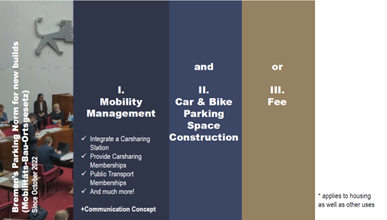On 16 January 2025, ShareDiMobiHub and SHARE-North Squared (SN²) came together in an exchange session to discuss the future of shared mobility hubs, share best practices, and explore how urban developments can integrate shared mobility solutions to enhance accessibility and reduce car dependency.
Both projects, co-funded by the Interreg North Sea Programme, work towards fostering sustainable urban mobility by embedding shared mobility into everyday life.
While ShareDiMobiHub focuses on improving urban multi-modal accessibility by deploying shared mobility hubs across cities and integrating them into Mobility as a Service (MaaS) ecosystems, SHARE-North Squared (SN2) explores how shared mobility can be embedded within real estate developments to enhance spatial efficiency, affordability, and accessibility while reducing car dependency.
Embedding shared mobility in real estate
The SHARE-North Squared (SN²) project brings a unique dimension to shared mobility by embedding shared mobility hubs directly into housing developments. By doing so, SN² aims to make shared transport an integral part of urban living, reducing parking needs, lowering housing costs, and fostering a car-light lifestyle from the outset.
Key Insights from the exchange
Legislative and policy innovations: The Mobility-Building Ordinance (Mobilitäts-Bau-Ortsgesetz) in Bremen serves as an example of how regulatory frameworks can encourage shared mobility adoption. This law mandates developers to implement mobility measures such as car-sharing services, high-quality bike parking, and public transport memberships in new developments.
Targeting urban developments for maximum impact: SN² partners explored the potential of closed (resident-only) versus open (publicly accessible) shared mobility services. Examples from Amsterdam, Bremen, and Turnhout demonstrated how mixed-use hubs can benefit both residents and the wider community.

Effective communication and user engagement: Bremen shared insights on its mandatory communication concept, which includes onboarding events, signage, and digital platforms to ensure that residents are aware of their shared mobility options. Creative outreach methods, such as “Carsharing Tupper Parties” and printed promotional materials, have proven effective in increasing uptake.
Impact on car ownership and mobility behaviour: A study on Bremen’s residential mobility policies (here in German) found that the availability of shared mobility services directly reduces car ownership. Residents with access to shared mobility were significantly more likely to adopt multimodal travel habits.
Scaling up shared mobility networks: The discussion also touched on the potential for a citywide network of shared mobility hubs, combining publicly accessible and residential hubs into an integrated, multimodal transport system. Best practices from Bremen, Aarhus, and the Netherlands underscored the importance of strategic location planning and partnerships with shared mobility providers.
Building a shared mobility future together
The collaboration between ShareDiMobiHub and SN² demonstrates how different approaches to shared mobility—whether through citywide hubs or integration into housing developments—can reinforce each other. By aligning efforts, sharing insights, and leveraging policy frameworks, both projects aim to accelerate the transition towards sustainable, multimodal urban transport.
As these initiatives continue to develop, further knowledge exchange and potential joint actions will help scale up shared mobility hubs across Europe and create a lasting impact on urban mobility and real estate planning.
